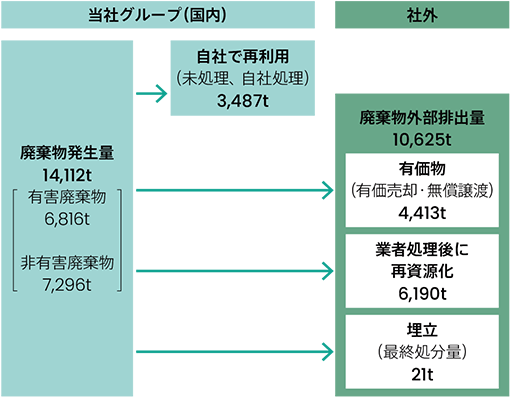Waste Management
Basic approach
artience group is a manufacturing company, and waste generation is inevitable in its production activities. Waste oil, waste plastics, and wastewater account for about 80% of the external waste emissions in Japan, and we are focusing on these and promoting measures. Specifically, we are working to minimize external waste emissions through the development of production processes that are less likely to generate waste, the study of waste disposal methods, the promotion of resource recycling such as reuse and recycling, and the global sharing of know-how on waste reduction.
Targets and achievements
Targets
Goals for material issues (material issue 2)
artience Targets for 2027 (FY2024~FY2026)
Achievements
In fiscal 2023, the amount of waste generated in Japan was 14,112 tons (down 19.2% from FY2022) and 12,341 tons overseas (down 14.4% from FY2022). This is due to a company-wide decrease in waste as well as a decrease in production volume. External waste emissions in Japan were 10,625 tons (down 21.1% compared to FY2022), which was reduced by actively promoting on-site treatment and reuse.
Going forward, we will continue to reduce emissions as much as possible by focusing on items that are frequently generated at our manufacturing sites, and we will continue to study wastewater treatment methods to reduce the amount of waste generated by 50% compared to FY2020, which is the target for 2030.
The final disposal rate of waste generated in Japan is 0.15%, and we have achieved zero emissions at all of our business sites.


Scope of aggregation: Major domestic factories and factories and domestic affiliates
- In fiscal 2022, the figures for Kansai Branch (Neyagawa), Kansai Branch (Toyama), Chubu Branch (Kasugai), TOYO INK Hokkaido Co., Ltd., TOYO INK Chugoku and Shikoku Co., Ltd. (Okayama), TOYO INK Chugoku and Shikoku Co., Ltd. (Takamatsu), and TOYO INK Kyushu Co., Ltd. (Fukuoka) are included in domestic affiliates.
- In FY2023, there was a consolidation and abolition of organizations at TOYO INK Co., Ltd., but the scope of aggregation remains unchanged from FY2022
The Big Picture of Waste
Based on the Ministry of the Environment's "Manual for the Formulation of Industrial Waste Disposal Plans by Businesses with Large Waste Dischargers," the amount of industrial waste that is outsourced to a contractor (waste for which a manifest is issued at the time of outsourcing treatment), as well as the amount of waste before intermediate treatment, including valuable materials and reuse within the company, is aggregated as the amount of waste generated.
In addition, the amount of final disposal is defined as the amount of waste to be disposed of before volume reduction, such as incineration, and "zero emissions" is defined as "the amount of final disposal (final disposal rate) of the amount of waste generated is 1% or less."


Scope of aggregation: Major domestic factories and factories and domestic affiliates
- In FY2023, there was a consolidation and abolition of organizations at TOYO INK Co., Ltd., but the scope of aggregation remains unchanged from FY2022
- Education on proper waste management
- Reduction of waste solvents by introducing a solvent recycling system
- Promotion of Plastic Resource Recycling
Efforts to reduce industrial waste ~Succeeded in making sludge valuable by introducing sludge volume reduction equipment~
TOYO FPP Co., Ltd. (Kawaguchi) is developing a business centered on the manufacture of cylinder plates and flexographic plates, and wastewater treatment is indispensable in the process of plate-making. Sludge is generated in the wastewater treatment process at the site, and until now, it has been necessary to treat it as industrial waste, and reducing costs has been an issue.
On the other hand, the Sustainability Vision ASV2050/2030 calls for a 50% reduction in external waste emissions in Japan by 2030 (compared to FY2020).
As part of our efforts to achieve the target, we considered reducing the volume of sludge generated by approximately 45 tons per year, and by introducing a thermal storage drying system, we were able to reduce the total amount of industrial waste generated by TOYO FPP Co., Ltd. by about 20%. In addition to reducing transportation costs, it is possible to recycle the metal components contained in the sludge as valuable materials by finding a material recycling destination.
As a result, the amount of industrial sludge generated in the wastewater treatment process is virtually zero. In the future, we will continue to study how to ensure stable processing as production increases.

May 16, 2023 Examination of optimization conditions after introduction
